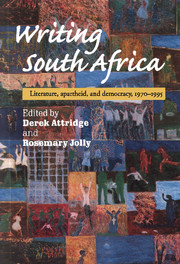Book contents
- Frontmatter
- Contents
- Contributors
- Acknowledgements and note on references
- South Africa, 1930–1996: a chronology
- Maps
- 1 Introduction
- 2 Interrogating silence: new possibilities faced by South African literature
- 3 I am dead: you cannot read: André Brink's On the Contrary
- 4 Endings and new beginning: South African fiction in transition
- 5 The post-apartheid sublime: rediscovering the extraordinary
- 6 Postmodernism and black writing in South Africa
- 7 Shame and identity: the case of the coloured in South Africa
- 8 A man's world: South African gay writing and the State of Emergency
- 9 The final safari: on nature, myth, and the literature of the Emergency
- 10 Interview
- 11 Speech and silence in the fictions of J.M.Coetzee
- 12 ‘Dialogue’ and ‘fulfilment’ in J.M. Coetzee's Age of Iron
- 13 Interview
- 14 Inside out: Jeremy Cronin's lyrical politics
- 15 Spinning out the present: narrative, gender, and the politics of South African theatre
- 16 South African theatre in the United States: the allure of the familiar and of the exotic
- Position papers
- Select bibliography: South African literary writing in English, 1970–1995
- Index
9 - The final safari: on nature, myth, and the literature of the Emergency
Published online by Cambridge University Press: 05 July 2011
- Frontmatter
- Contents
- Contributors
- Acknowledgements and note on references
- South Africa, 1930–1996: a chronology
- Maps
- 1 Introduction
- 2 Interrogating silence: new possibilities faced by South African literature
- 3 I am dead: you cannot read: André Brink's On the Contrary
- 4 Endings and new beginning: South African fiction in transition
- 5 The post-apartheid sublime: rediscovering the extraordinary
- 6 Postmodernism and black writing in South Africa
- 7 Shame and identity: the case of the coloured in South Africa
- 8 A man's world: South African gay writing and the State of Emergency
- 9 The final safari: on nature, myth, and the literature of the Emergency
- 10 Interview
- 11 Speech and silence in the fictions of J.M.Coetzee
- 12 ‘Dialogue’ and ‘fulfilment’ in J.M. Coetzee's Age of Iron
- 13 Interview
- 14 Inside out: Jeremy Cronin's lyrical politics
- 15 Spinning out the present: narrative, gender, and the politics of South African theatre
- 16 South African theatre in the United States: the allure of the familiar and of the exotic
- Position papers
- Select bibliography: South African literary writing in English, 1970–1995
- Index
Summary
In April 1988, while the second official State of Emergency was still in effect in South Africa and the international clamour for sanctions against the apartheid regime was growing louder, a startling full-page advertisement appeared in the Washington Post. It featured a picture of a zebra caught in a rifle gunsight, accompanied by the slogan ‘Shoot it in the white and the black also dies’ (20 April 1988). This maxim (which had for years been a favourite weapon in Foreign Minister Pik Botha's rhetorical arsenal) is on a certain level undeniably true. The text's deviousness lies elsewhere, in the analogy between the signifier (the zebra) and the signified (the South African state). It is an analogy which turns something that has been constructed – constructed by people and through history – into something that is natural and given. With ostentatious candour the advertisement seems to address the matter of racial difference, but it renders the meaning of that difference innocent, even decorative. It turns the deep contradiction of a society in which some are rich at the expense of others into a matter of surface contrast: the elegance of the zebra's stripes. In its address to a foreign audience, moreover, the image positions its reader as a tourist on safari. It invites him or her to think of South Africa not as a site of political strife, but as an exotic beast, best looked at through the photographer's telephoto lens: as something to be celebrated and conserved – emphatically not something to take pot shots at.
- Type
- Chapter
- Information
- Writing South AfricaLiterature, Apartheid, and Democracy, 1970–1995, pp. 123 - 140Publisher: Cambridge University PressPrint publication year: 1998
- 1
- Cited by



